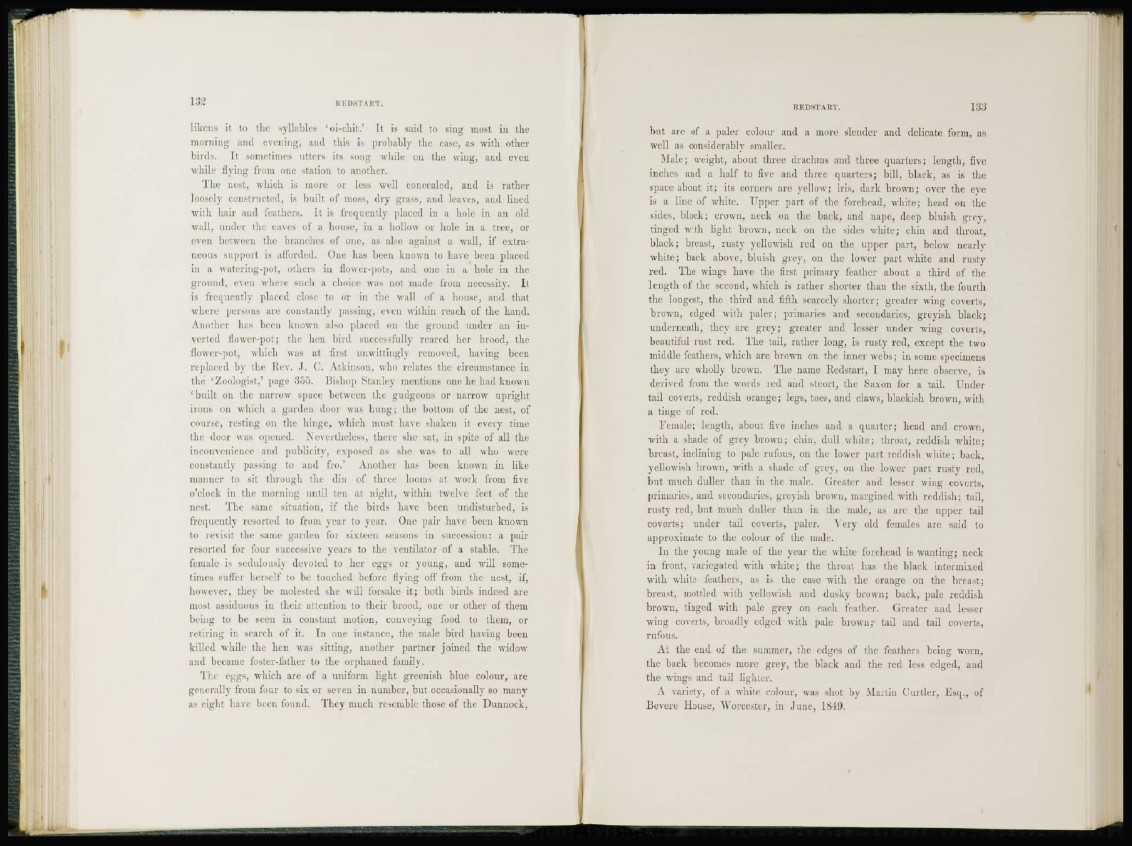
Likens it to the syllables 'oi-chit.' It is said to sing most in the
morning and evening, and this is probably the case, as with other
birds. It sometimes utters its song while on the wing, and even
while living from one station to another.
The nest, which is more or less well concealed, and is rather
loosely constructed, is built of moss, dry grass, and leaves, and lined
with hair and feathers. It is frequently placed in a hole in an old
wall, under the caves of a house, in a hollow or hole in a tree, or
even between the branches of one, as also against a wall, if extraneous
support is afforded. One has been known to have been placed
in a watering-pot, others in flower-pots, and one in a hole in the
ground, even where such a choice was not made from necessity. It
is frequently placed close to or in the wall of a house, and that
where persons are constantly passing, even within reach of the hand.
Another has been known also placed on the ground under an inverted
flower-pot; the hen bird successfully reared her brood, the
flower-pot, -which was at first unwittingly removed, having been
replaced by the Rev. J. 0. Atkinson, who relates the circumstance in
the 'Zoologist,' page 3o5. Bishop Stanley mentions one he had known
'built on the narrow space between the gudgeons or narrow upright
irons on which a garden door was hung; the bottom of the nest, of
course, resting on the hinge, which must have shaken it every time
the door was opened. Ne\erthcless, there she sat, in spite of all the
inconvenience and publicity, exposed as she was to aU who were
constantly passing to and fro." Another has been known in like
manner to sit through the din of three looms at work from five
o'clock in the morning until ten at night, within twelve feet of the
nest. The same situation, if the birds have been undisturbed, is
frequently resorted to from year to year. One pair have been known
to revisit the same garden for sixteen seasons in succession: a pair
resorted for four successive years to the ventilator of a stable. The
female is sedulously devoted to her eggs or young, and will sometimes
suffer herself to be touched before flying off from the nest, if,
however, they be molested she will forsake it; both birds indeed are
most assiduous in their attention to their brood, one or other of them
being to be seen in constant motion, conveying food to them, or
retiring in search of it. In one instance, the male bird having been
killed while the hen was sitting, another partner joined the wddowr
and became foster-father to the orphaned family.
The eggs, which are of a uniform light greenish blue colour, are
generally from four to six or seven in number, but occasionally so many
as eight have been found. They much resemble those of the Dunnock,
hut are of a paler colour and a more slender and delicate form, as
well as considerably smaller.
Male; weight, about three drachms and three quarters; length, five
inches and a half to five and three quarters; bill, black, as is the
space about it; its corners are yellow; iris, dark brown; over the eye
is a line of white. Upper part of the forehead, white; head on the
sides, black; crown, neck on the back, and nape, deep bluish grey,
tinged with light brown, neck on the sides white; chin and throat,
black; breast, rusty yellowish red on the upper part, below nearly
white; back above, bluish grey, on the lower part white and rusty
red. The wings have the first primary feather about a third of the
length of the second, which is rather shorter than the sixth, the fourth
the longest, the third and fifth scarcely shorter; greater wing coverts,
brown, edged with paler; primaries and secondaries, greyish black;
underneath, they arc grey; greater and lesser under wing coverts,
beautiful rust red. The tail, rather long, is rusty red, except the two
middle feathers, which are brown on the inner webs; in some specimens
they are wholly brown. The name Redstart, I may here observe, is
derived from the words red and steort, the Saxon for a tail. Under
tail coverts, reddish orange; legs, toes, and claws, blackish brown, with
a tinge of red.
Female; length, about five inches and a quarter; head and crown,
with a shade of grey brown; chin, dull white; throat, reddish wdiite;
breast, inclining to pale rufous, on the lower pert reddish white; back,
yellowish brown, with a shade of grey, on the lower part rusty red,
but much duller than in the male. Greater and lesser wing coverts,
primaries, and secondaries, greyish brown, margined with reddish; tail,
rusty red, but much duller than in the male, as are the upper tail
coverts; under tail coverts, paler. A ery old females are said to
approximate to the colour of the male.
In the young male of the year the white forehead is wanting; neck
in front, variegated with white; the throat has the black intermixed
-with white feathers, as is the case with the orange on the breast;
breast, mottled with yellowish and dusky brown; back, pale reddish
brown, tinged with pale grey on each feather. Greater and lesser
wing coverts, broadly edged with pale brown;- tail and tail coverts,
rufous.
At the end of the summer, the edges of the feathers being worn,
the back becomes more grey, the black and the red less edged, and
the wings and tail lighter.
A variety, of a white colour, was shot by Martin Curtler, Esq., of
Beverc House, Worcester, in June, 1849.